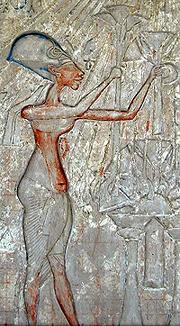 Akhnaten - Philip Glass
Akhnaten - Philip Glass
An Opera in 3 Acts
 Akhnaten - Philip Glass
Akhnaten - Philip Glass
An Opera in 3 Acts
| Akhnaten | Countertenor | Pharaoh, ne Amenhotep IV |
| Nefertiti | Contralto | Queen of Akhnaten |
| Queen Tye | Soprano | Grand Roayal Wife of Amenhotep III |
| Scribe | Narrator | |
| Ay | Bass | Chief advisor to three Pharaohs |
| Horemheb | Baritone | Diplomat, Army Commander in Chief |
| High Priest | Tenor | Priest of Amun |

|
|
Background: - see Note-1. Horizon: Used in this context, is the "horizon" between the world of the living and of the gods. Act 1: Year 1 of Akhnaten's Reign in Thebes, 1370 BCE Prelude
Scene-1 Funeral of Amenhotep III
Scene-2 Coronation of Amenhotep IV (later Akhnaten)
Scene-3 At the Window of Appearances
Act 2: Years 5 to 15 in Thebes and Akhet-Aten Scene-1 At the Temple of Amun
Scene-2 Akhnaten & Nefertiti
Scene-3 City of Akhet-Aten (Horizon of Aten)
Scene-4 Hymn to The Aten
Act 3: Year 17 & Present Scene-1 The Family
Scene-2 Attack on Akhet-Aten
Scene-3 The Ruins
Scene-4 Epilogue
------------------------------------ Note-1: There are many historical details that are not accurate - but, hey, it's an Opera, what do you expect? Glass' reason for picking Akhnaten was as a "world changer", as the founder of monotheism. Despite earlier ideas, modern scholarship finds no possible connection to Hebrew monotheism, which first formed 400 years later. The term now used for Akhnaten's religion is "henotheism", focus on one god without denying the existence of others. Note-2: Psalm-104 is much like Akhnaten's hymn, but it's also much like a whole lot of other hymns from it's time and from Akhnaten's time. Akhnaten's hymn had been erased for 400 years, except on the inside of a few tombs near the abandoned ruins of Akhet-Aten. Note-3: Akhet-Aten was not attacked and the royal family was not killed. The fall of Akhet-Aten was complex and took years. Some experts believe Nefertiti died well after Akhnaten, though exact date is unknown, and may have ruled as Pharaoh for a short time between the death of Akhnaten and the coronation of Tutenkhamun. The manner of Akhnaten's death is not known, but he was formally interred in a tomb near Akhet-Aten with the usual trappings - though it was later defiled. Obviously the family was not killed, as his son, Tutankhaten (Living Image of Aten) became Pharaoh. Two years later he changed his name to Tutenkhamun and moved the capital back to Thebes, begining restoration of the old religion. One of the six daughters may have briefly been Pharoah, if it wasn't Nefertiti. One seems to have been married to another Pharoah, and one was married to Tutenkhamun. It is hard to know the details because Horemheb tried to erase the entire Amarna period as part of his stabalization program. Tutankhamun appointed Horemheb as his successor, but Ay seized the throne upon his death. Horemheb was with the Army in Asia at the time. Ay's rule was only 4 years, and Horemheb seized the throne upon his death. Horemheb set about destroying monuments to Akhnaten, Tutenkamun, Ay, and whoever it was who was Pharoah between the death of Akhnaten and coronation of Tutenkamun. Horemheb ruled for 14 years and appointed his vizar Paramesse as his succssor. Under the name Ramesses I, he founded the 19th Dynasty, but died in less than 2 years. He was followed by his son, Seti I who reigned for around 10 years. Seti I was followed by his own son, the great warior Pharaoh Ramesses II, who reigned for 66 years and died at the age of 90. |